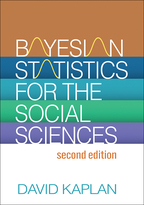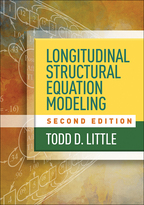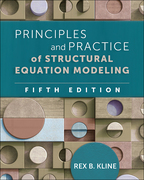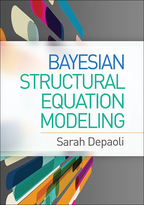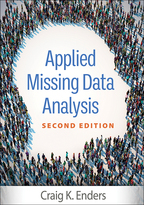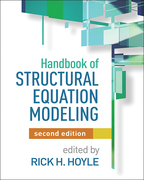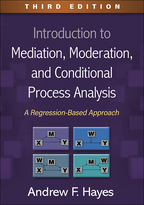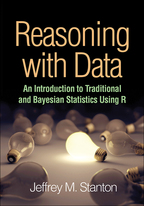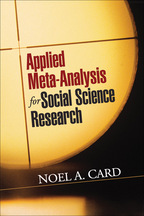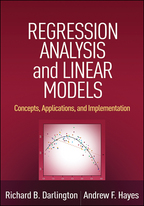Bayesian Statistics for the Social Sciences
Second Edition
David Kaplan
1. Probability Concepts and Bayes' Theorem
1.1 Relevant Probability Axioms
1.1.1 The Kolmogorov Axioms of Probability
1.1.2 The Rényi Axioms of Probability
1.2 Frequentist Probability
1.3 Epistemic Probability
1.3.1 Coherence and the Dutch Book
1.3.2 Calibrating Epistemic Probability Assessment
1.4 Bayes' Theorem
1.4.1 The Monty Hall Problem
1.5 Summary
2. Statistical Elements of Bayes' Theorem
2.1 Bayes' Theorem Revisited
2.2. Hierarchical Models and Pooling
2.3 The Assumption of Exchangeability
2.4 The Prior Distribution
2.4.1 Non-informative Priors
2.4.2 Jeffreys' Prior
2.4.3 Weakly Informative Priors
2.4.4 Informative Priors
2.4.5 An Aside: Cromwell's Rule
2.5 Likelihood
2.5.1 The Law of Likelihood
2.6 The Posterior Distribution
2.7 The Bayesian Central Limit Theorem and Bayesian Shrinkage
2.8 Summary
3. Common Probability Distributions and Their Priors
3.1 The Gaussian Distribution
3.1.1 Mean Unknown, Variance Known: The Gaussian Prior
3.1.2 The Uniform Distribution as a Non-informative Prior
3.1.3 Mean Known, Variance Unknown: The Inverse-Gamma Prior
3.1.4 Mean Known, Variance Unknown: The Half-Cauchy Prior
3.1.5 Jeffreys' Prior for the Gaussian Distribution
3.2 The Poisson Distribution
3.2.1 The Gamma Prior
3.2.2 Jeffreys' Prior for the Poisson Distribution
3.3 The Binomial Distribution
3.3.1 The Beta Prior
3.3.2 Jeffreys' Prior for the Binomial Distribution
3.4 The Multinomial Distribution
3.4.1 The Dirichlet Prior
3.4.2 Jeffreys' Prior for the Multinomial Distribution
3.5 The Inverse-Wishart Distribution
3.6 The LKJ Prior for Correlation Matrices
3.7 Summary
4. Obtaining and Summarizing the Posterior Distribution
4.1 Basic Ideas of Markov Chain Monte Carlo Sampling
4.2 The Random Walk Metropolis–Hastings Algorithm
4.3 The Gibbs Sampler
4.4 Hamiltonian Monte Carlo
4.4.1 No-U-Turn (NUTS) Sampler
4.5 Convergence Diagnostics
4.5.1 Trace Plots
4.5.2 Posterior Density Plots
4.5.3 Auto-Correction Plots
4.5.4 Effective Sample Size
4.5.5 Potential Scale Reduction Factor
4.5.6 Possible Error Messages When Using HMC/NUTS
4.6 Summarizing the Posterior Distribution
4.6.1 Point Estimates of the Posterior Distribution
4.6.2 Interval Summaries of the Posterior Distribution
4.7 Introduction to Stan and Example
4.8 An Alternative Algorithm: Variational Bayes
4.8.1 Evidence Lower Bound (ELBO)
4.8.2 Variational Bayes Diagnostics
4.9 Summary
II. Bayesian Model Building
5. Bayesian Linear and Generalized Models
5.1 The Bayesian Linear Regression Model
5.1.1 Non-informative Priors in the Linear Regression Model
5.2 Bayesian Generalized Linear Models
5.2.1 The Link Function
5.3 Bayesian Logistic Regression
5.4 Bayesian Multinomial Regression
5.5 Bayesian Poisson Regression
5.6 Bayesian Negative Binomial Regression
5.7 Summary
6. Model Evaluation and Comparison
6.1 The Classical Approach to Hypothesis Testing and Its Limitations
6.2 Model Assessment
6.2.1 Prior Predictive Checking
6.2.2 Posterior Predictive Checking
6.3 Model Comparison
6.3.1 Bayes Factors
6.3.2 The Deviance Information Criterion (DIC)
6.3.3 Widely Applicable Information Criterion (WAIC)
6.3.4 Leave-One-Out Cross-Validation
6.3.5 A Comparison of WAIC and LOO
6.4 Summary
7. Bayesian Multilevel Modeling
7.1 Revisiting Exchangeability
7.2 Bayesian Random Effects Analysis of Variance
7.3 Bayesian Intercepts as Outcomes Model
7.4 Bayesian Intercepts and Slopes as Outcomes Model
7.5 Summary
8. Bayesian Latent Variable Modeling
8.1 Bayesian Estimation for the CFA
8.1.1 Priors for CFA Model Parameters
8.2 Bayesian Latent Class Analysis
8.2.1 The Problem of Label-Switching and a Possible Solution
8.2.2 Comparison of VB to the EM Algorithm
8.3 Summary
III. Advanced Topics and Methods
9. Missing Data From a Bayesian Perspective
9.1 A Nomenclature for Missing Data
9.2 Ad Hoc Deletion Methods for Handling Missing Data
9.2.1 Listwise Deletion
9.2.2 Pairwise Deletion
9.3 Single Imputation Methods
9.3.1 Mean Imputation
9.3.2 Regression Imputation
9.3.3 Stochastic Regression Imputation
9.3.4 Hot Deck Imputation
9.3.5 Predictive Mean Matching
9.4 Bayesian Methods for Multiple Imputation
9.4.1 Data Augmentation
9.4.2 Chained Equations
9.4.3 EM Bootstrap: A Hybrid Bayesian/Frequentist Methods
9.4.4 Bayesian Bootstrap Predictive Mean Matching
9.4.5 Accounting for Imputation Model Uncertainty
9.5 Summary
10. Bayesian Variable Selection and Sparsity 
10.1 Introduction
10.2 The Ridge Prior
10.3 The Lasso Prior
10.4 The Horseshoe Prior
10.5 Regularized Horseshoe Prior
10.6 Comparison of Regularization Methods
10.6.1 An Aside: The Spike-and-Slab Prior
10.7 Summary
11. Model Uncertainty
11.1 Introduction
11.2 Elements of Predictive Modeling
11.2.1 Fixing Notation and Concepts
11.2.2 Utility Functions for Evaluating Predictions
11.3 Bayesian Model Averaging
11.3.1 Statistical Specification of BMA
11.3.2 Computational Considerations
11.3.3 Markov Chain Monte Carlo Model Composition
11.3.4 Parameter and Model Priors
11.3.5 Evaluating BMA Results: Revisiting Scoring Rules
11.4 True Models, Belief Models, and M-Frameworks
11.4.1 Model Averaging in the M-Closed Framework
11.4.2 Model Averaging in the M-Complete Framework
11.4.3 Model Averaging in the M-Open Framework
11.5 Bayesian Stacking
11.5.1 Choice of Stacking Weights
11.6 Summary
12. Closing Thoughts
12.1 A Bayesian Workflow for the Social Sciences
12.2 Summarizing the Bayesian Advantage
12.2.1 Coherence
12.2.2 Conditioning on Observed Data
12.2.3 Quantifying Evidence
12.2.4 Validity
12.2.5 Flexibility in Handling Complex Data Structures
12.2.6 Formally Quantifying Uncertainty
List of Abbreviations and Acronyms
References
Author Index
Subject Index

